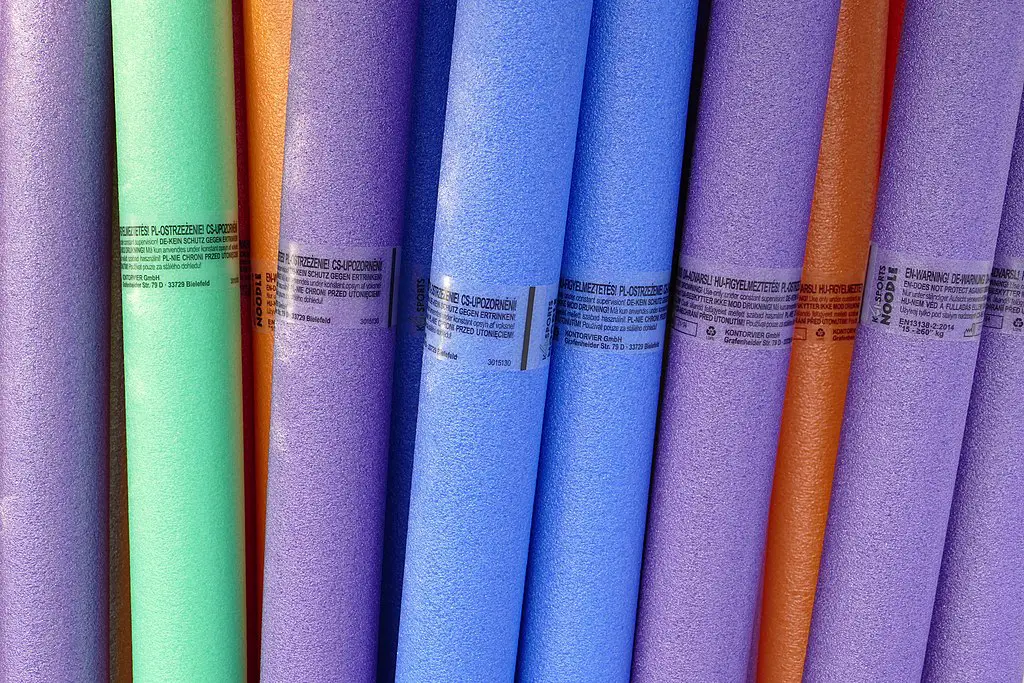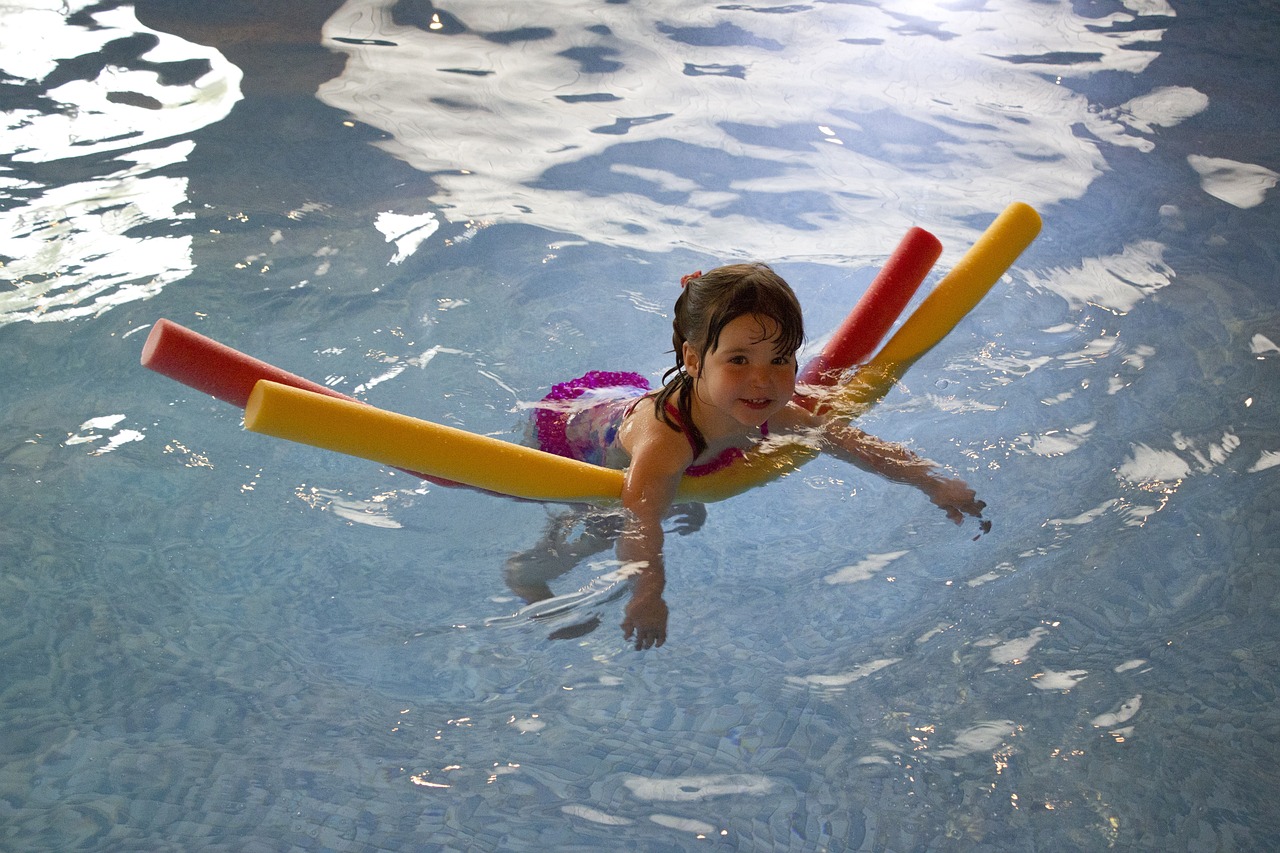Pool noodles are those long, cylindrical pieces of foam that you see kids smacking each other with and connecting one end to a spout and spraying other kids with like a hose.
These colorful tubes can measure up to 6 feet in length and 3 inches in diameter – the perfect size to smack people with, erm, I mean, to use as a swimming aid for both children and adults. Surely it is never used for any mischief.
Crafted from flexible, closed-cell foam, pool noodles boast impressive buoyancy while remaining lightweight and water-resistant. In addition to providing endless hours of play and relaxation, they can even be used for construction and DIY craft projects outside of the pool.
In this article, we will explore the many uses of pool noodles, their unique properties, and some creative ways to incorporate them into your swimming experience.
Brief Overview
A pool noodle is a long, cylindrical piece of buoyant polyethylene foam that comes in various colors and sizes. It is a popular swimming accessory used by people of all ages for fun, safety, and learning in the water. The natural properties of polyethylene give it excellent buoyancy and durability for water activities.
One of the unique features of a pool noodle is its hollow structure. This design not only makes it lightweight and easy to handle but also opens up a world of creative possibilities for using the noodle in various water games and activities. In addition, the noodle’s resilience and ability to bend and bounce back make it perfect for both play and exercise in the water.
These versatile pool toys can be used for many purposes, such as learning to swim, floating, rescue-reaching, water play, and even aquatic exercises.
What Are Pool Noodles Made Of?

Let’s talk a little bit more about polyethylene foam. This foam is comprised of millions of tiny bubbles pressed together, making it a closed-cell foam. The structure of polyethylene foam prevents water from penetrating the cells, allowing the pool noodle to float effortlessly.
The unique characteristics of polyethylene foam provide pool noodles with their bendiness and quick return to their original shape when compressed. This resilience is what makes them an ideal flotation device for swimming pools, used by both children and adults alike.
There are different types of pool noodles available, varying in firmness and flexibility. Some noodles are made with a denser material that offers better support in the water, especially for larger adults. On the other hand, less dense materials can create a flimsier noodle, suitable for bending and shaping during play.
Closed-Cell vs. Open-Cell Foam
When shopping for a pool noodle, you may come across the terms closed-cell and open-cell foam. What do they mean? Without getting too technical:
Closed-cell foam is strong and durable, which means it can last a long time and handle rough play. It’s also less likely to get waterlogged, which means it will stay buoyant and keep you afloat. Closed-cell foam pool noodles are great for water sports and activities where you need something tough and long-lasting.
Open-cell foam is softer and more flexible, which means it’s more comfortable to use. It’s also lighter and less expensive than closed-cell foam. However, it can get waterlogged over time, which means it might not float as well as a closed-cell foam pool noodle. Open-cell foam pool noodles are great for casual swimming and playing in the water.
So, if you want a pool noodle that will last a long time and handle lots of rough play, go for a closed-cell foam noodle. But if you want something that’s soft and comfortable to use, go for an open-cell foam noodle.
Popular Uses for Pool Noodles
Swimming Aid
Pool noodles are often used as swimming aids to help individuals stay afloat in the water. You can drape your arms over it and let it hold you afloat from your armpits.
Their buoyant nature allows beginners and those who may be unsteady in the water to maintain their balance and improve their swimming skills. Moreover, they function as versatile floating devices for relaxation and lounging sessions in the pool.
To be clear: out of all the swimming flotation devices, pool noodles are arguably the least reliable because they are not secured tightly on you. Do not actually rely on one to keep you afloat if you don’t know how to swim. Wear a life jacket instead.
Water Games
As fun and inexpensive toys, pool noodles can be incorporated into a variety of water games. For instance, they can be used to create hurdles or goalposts for water sports such as water polo or noodle tag. Additionally, you can transform pool noodles into Star Wars light sabers for entertaining water battles.
Crafts Projects

Pool noodles are also popular choices for crafts and DIY projects. Some creative ideas include making pool noodle garlands for special occasions, designing race tracks for marble runs, and constructing birthday candles that can be reused year after year. The versatility of pool noodles allows for endless crafting possibilities, sparking creativity in adults and children alike.
Families can also use pool noodles to build a kiddie car wash for backyard fun. Furthermore, they can be used as a door stopper to prevent injuries to little fingers or repurposed as hangers for an organized closet.
DIY Home Projects
Apart from crafts, pool noodles can be put to practical use in various DIY projects around the house. For instance, they can be employed as foam insulation for pipes thanks to their insulating properties. Pool noodles with slits make it easier to attach them to pipes, providing a cost-effective solution for keeping pipes insulated during winter months.
Other practical uses include creating floating coolers for pool parties, serving as bed rails to prevent children from falling out of bed, or even being converted into card holders for game night fun. Pool noodles provide a versatile, affordable, and accessible material for numerous DIY projects that can save time, money, and effort.
How Much Weight Can a Pool Noodle Support?
Foam pool noodles can support weight up to 300 pounds, depending on the size of the noodle.
The load capacities of typical 4″ diameter pool noodles are about 200 lbs for a 4-ft long noodle and about 300 lbs for a 5-ft long one. Classic foam pool noodles are highly buoyant and can keep a person above water.
Check the product page or packaging of your pool noodle to see exactly how much weight your pool noodle can support.
Caring for Pool Noodles
Storage and Maintenance
Storing and maintaining your pool noodles is crucial to keep them in good condition. After each use, make sure to rinse them off with clean water to remove any chlorine, salt, or dirt that may have accumulated during use. Allow the pool noodles to air dry completely before storing them away.
Ideal storage for pool noodles involves placing them in a cool, dry, and well-ventilated area away from direct sunlight, as exposure to sunlight or high heat can cause the foam to become damaged or melt. You can use a large container, a mesh bag, or even PVC pipe organizers to keep them organized and prevent them from getting crushed or damaged.
Increasing Longevity
There are a couple of things you can do to increase the longevity of your pool noodles. The first step is to avoid exposing them to high temperatures, as mentioned above.
To prevent additional wear and tear, do not sit or stand on pool noodles, as this can cause them to lose their shape or become overly compressed. Though they can be bent, bending them too much can cause them to tear.
When using pool noodles for crafts, avoid applying hot glue directly to the foam, as it may melt the noodle. Instead, apply the glue quickly and carefully in small amounts to prevent melting.
Regularly inspect your pool noodles for signs of damage, such as cracks or tears. If damage is found, it’s best to replace the noodle to prevent further deterioration and ensure a safe and enjoyable experience while swimming or crafting.
How Long is a Pool Noodle?

Pool noodles come in various lengths to suit the user’s needs and preferences.
The most common length range is between 48 to 60 inches long, with the standard size for a pool noodle being 55 inches long (approximately 4.5 feet) with a 2 3/8-inch diameter.
However, there are longer and shorter noodles available in the market as well. The length you choose may depend on how you plan to use your pool noodle and your personal preferences.
Are Pool Noodles Waterproof?
Polyethylene foam not only grants pool noodles their lightweight and buoyant nature, but it also ensures that they can handle water exposure.
Pool noodles are actually quite similar to the industrial and residential foam insulation used on pipes, which require a significant level of water resistance. Their waterproof quality is one of the reasons pool noodles continue to be a favorite accessory for water activities.
However, it’s important to remember that while pool noodles are generally water-resistant, they can still absorb a small amount of water over time. This could lead to some degree of wear and tear, but shouldn’t have a significant impact on its functionality, especially if the noodle is properly cared for and stored after use.
Are Pool Noodles Toxic?
Pool noodles are a popular swimming accessory made of flexible, buoyant polyethylene foam. Many people wonder about the safety of these fun swim toys, especially in regards to their potential toxicity. Rest assured, pool noodles are generally safe, as long as they are used appropriately and with caution.
Most pool noodles are made with ethylene-vinyl acetate (EVA), a safe material often used in foam float belts and mats (Home Matters | AHS). While EVA-made products pose little risk if accidentally swallowed, it’s essential to supervise young children to prevent choking.
In some cases, pool flotation devices are made of polyvinyl chloride (PVC) and phthalates. These materials have a low risk of causing problems when ingested, usually through inhalation (Fun Facts About Pool Noodles & Their Many Uses). That strong smell of a new shower curtain or plastic toy is a common indicator of PVC and phthalates in a product.
Some safety tips for using pool noodles include:
- Don’t chew or eat pool noodles. Watch your young child(ren) and pets like a hawk to make sure this never happens!
- Always wear a life jacket when using pool noodles for flotation
- Supervise children and non-swimmers to prevent drowning or choking risks
Pool noodles are safe when used correctly, and they should pose no significant health risks. That said, children and pets like cats and dogs don’t know any better and may want to nom on it.
As the supervising adult, you must be vigilant and keep your precious babies from snacking on these inedible “noodles”.
Are Pool Noodles Biodegradable?
As with any plastics, as responsible humans, we must care about their environmental impact.
Most pool noodles are made of polyethylene foam, a type of synthetic plastic material (Stockton Recycles). Unfortunately, polyethylene isn’t readily biodegradable, which means it doesn’t decompose easily in the environment. As a result, if pool noodles end up as litter or in landfills, they can contribute to pollution and waste accumulation.
If you leave them in the pool all the time where it is exposed to chlorine and UV rays, it will start to disintegrate and clog up your pool filters.
Because pool noodles are difficult to recycle (Napa Recycling and Waste Services), it’s essential to take proper care of them and reuse them as much as possible. If you’re looking for an eco-friendlier alternative, you can consider exploring options made from more sustainable materials, such as high-quality EPE materials that are safer and more eco-friendly.
Before purchasing your next pool noodle, take a moment to research the product’s material and consider its environmental impact. While enjoying our time in the water, it’s vital to think about the long-term effects of our choices on the environment.
Alternatives to Pool Noodles
Inflatable Water Toys
Inflatable water toys are a popular alternative to pool noodles. They come in different shapes and sizes, and they are usually made of PVC or vinyl.
Some popular inflatable water toys include inflatable rafts, tubes, and lounges. However, it’s important to note that, like pool noodles, most inflatable pool toys are also not biodegradable.
Other Types of Foam Products
In addition to foam pool noodles, there are other foam products that can be used as alternatives. For example, some people use foam water dumbbells or foam water weights for water aerobics or swimming workouts. Foam kickboards and foam mats are also popular alternatives to pool noodles.
Photo Credits: Saigon Soul, CC BY 2.0, Kritzolina, CC BY-SA 4.0


